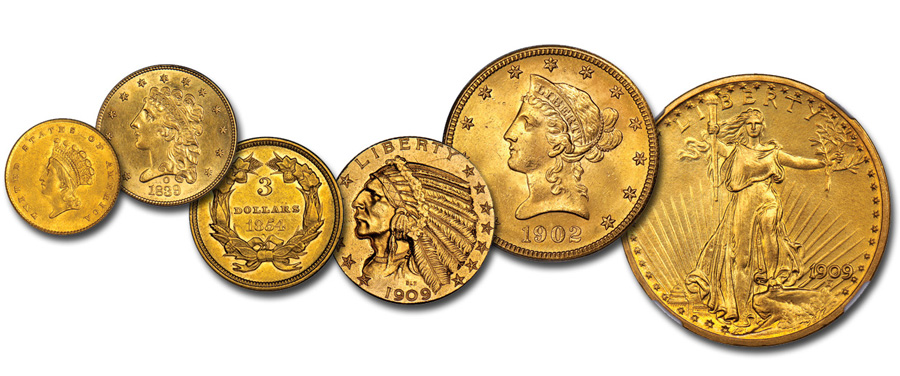
I continue and conclude this feature started two weeks ago. With the price of bullion gold being at a record recent low, high denomination gold coins are less expensive now than they have been in several years. Double eagles, the most popular denomination collected, have decreased in price by hundreds of dollars — referring to common dates and mintmarks. With Robert Galiette, I recently completed a book on Liberty Head double eagles for Stack’s Bowers Galleries. I promise it will be a great read, a combination of history and numismatics. Watch for a pre-publication offer soon!
Double Eagle ($20 Gold)
Liberty Head, Type 1. 1850-1866. Designed by Chief Engraver James B. Longacre, the obverse motif of the first type in the series features Miss Liberty in the same style as used on the gold dollar struck in 1849. The reverse shows an eagle with resplendent rays above and decorative elements to the left and right. The denomination is expressed as TWENTY D. Thanks to the recovery of treasure from certain lost ships such as the S.S. Central America, S.S. Brother Jonathan and S.S. Republic Mint State examples are readily available of this type, the most plentiful being the 1857-S issues from the S.S. Central America, of which over 5,000 were recovered. One might think that the market would be depressed with such a find, but the opposite proved to be true as nearly all the coins and ingots from that treasure are worth substantially more in 2014 than they were back when distribution began in 2000. Beyond that, the availability of such pieces has sharply increased collector interest in Liberty Head double eagles in general.
Liberty Head, Type 2, With Motto, TWENTY D. 1866-1876. The reverse was modified by adding the motto IN GOD WE TRUST in early 1866. Of the various types of double eagles this is the most difficult to obtain in higher levels of Mint State. Accordingly there is a challenge. However, in grades such as EF and AU they are plentiful.
Liberty Head, Type 3, With Motto, TWENTY DOLLARS. 1877-1907. In 1877 the denomination was first spelled out as TWENTY DOLLARS creating the third and final type. The motto was retained. Double eagles of this style were made continuously through 1907, with modest mintages in some years and large production in others. For type set purposes varieties around the turn of the 20th century are relatively common in Mint State.
MCMVII High Relief (1907). This is the American coin that everyone loves — considered by many to be the most beautiful design ever made for regular circulation. The story of its production is well known. In brief, President Theodore Roosevelt visited the Smithsonian Institution in 1904 and was impressed with the beautiful sculptured relief of coins of ancient Greece. He wondered whether American coinage could have similar artistry, and eventually contacted Augustus Saint-Gaudens, America’s most famous sculptor at the time, and an arrangement was made for the artist to redesign all denominations from the cent to the double eagle. He was in increasingly poor health and passed away on August 3, 1907, by which time he had nearly completed the designs for the $10 and $20, to which the finishing touches were added by an assistant, Henry Hering. Charles E. Barber, chief engraver at the Mint, protested that the high relief design could not be struck up properly on a normal coining press. Roosevelt didn’t care and stated that if only one coin per day could be minted, that’s how it would be! Roosevelt called this his “pet crime.” It turned out that three blows of the press were needed. After 12,367 pieces were struck in December 1907 and from the same dies in early 1908, production ceased. The distribution of the MCMVII pieces was a sensation widely covered in the papers. Demand was intense, and the price quickly rose to $28 or more as bank tellers fortunate enough to find them had many eager buyers who would give them a tip or pay a premium. Accordingly, many were saved. In 1933 when President Franklin Roosevelt ordered the general public to turn in gold coins, probably thousands were surrendered. Still, enough remain that today I estimate that perhaps 6,000 or so, or about half the original mintage, still survive. Average grades range from AU to low Mint State. At the MS-64 and MS-65 levels the pieces are relatively scarce. This will be the most expensive basic coin in your gold type set.
Saint-Gaudens, Arabic Date, Without Motto. 1907-1908. In December 1907 Chief Engraver Charles E. Barber had his way, altered the design, lowered the relief, removed the Roman numerals, and struck the motif in shallow relief. These were made in quantity. Although the design was short lived, the vast Wells Fargo hoard with nearly 20,000 Mint State pieces provides the easy source for acquiring choice and gem examples at relatively low prices.
Saint-Gaudens. Arabic Date, With Motto. 1908-1933. In 1908 Congress restored the motto and from that point forward all had IN GOD WE TRUST on the reverse. This style was produced in large quantities, and for type set purposes examples are very easily obtained today. The price is usually based on bullion, so if an ounce of bullion is worth a given amount, an Uncirculated double eagle in, say, MS-62 or MS-63 grade, is some modest percentage over that. Today in 2014 such pieces are less expensive than they have been for several years.
This concludes my comments. If you form a type set you will enjoy the experience. Take time to read about each design as you acquire it.





